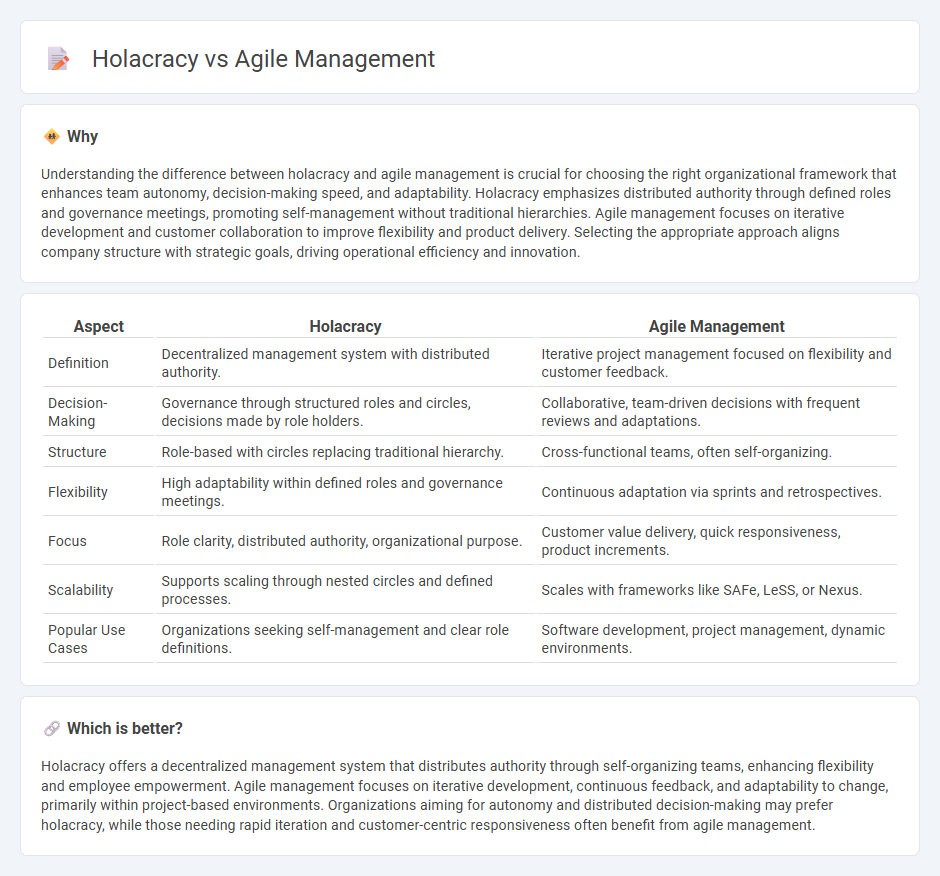
Holacracy offers a decentralized approach to management by distributing authority across self-organizing teams, enhancing transparency and accountability, while Agile management focuses on iterative development, customer collaboration, and adaptability to changing requirements. Both frameworks prioritize flexibility and empower teams but differ in structure and decision-making processes, with Holacracy using formalized roles and governance meetings versus Agile's emphasis on sprints and continuous feedback. Explore the distinct advantages and practical applications of Holacracy and Agile management to optimize your organizational performance.
Why it is important
Understanding the difference between holacracy and agile management is crucial for choosing the right organizational framework that enhances team autonomy, decision-making speed, and adaptability. Holacracy emphasizes distributed authority through defined roles and governance meetings, promoting self-management without traditional hierarchies. Agile management focuses on iterative development and customer collaboration to improve flexibility and product delivery. Selecting the appropriate approach aligns company structure with strategic goals, driving operational efficiency and innovation.
Comparison Table
| Aspect | Holacracy | Agile Management |
|---|---|---|
| Definition | Decentralized management system with distributed authority. | Iterative project management focused on flexibility and customer feedback. |
| Decision-Making | Governance through structured roles and circles, decisions made by role holders. | Collaborative, team-driven decisions with frequent reviews and adaptations. |
| Structure | Role-based with circles replacing traditional hierarchy. | Cross-functional teams, often self-organizing. |
| Flexibility | High adaptability within defined roles and governance meetings. | Continuous adaptation via sprints and retrospectives. |
| Focus | Role clarity, distributed authority, organizational purpose. | Customer value delivery, quick responsiveness, product increments. |
| Scalability | Supports scaling through nested circles and defined processes. | Scales with frameworks like SAFe, LeSS, or Nexus. |
| Popular Use Cases | Organizations seeking self-management and clear role definitions. | Software development, project management, dynamic environments. |
Which is better?
Holacracy offers a decentralized management system that distributes authority through self-organizing teams, enhancing flexibility and employee empowerment. Agile management focuses on iterative development, continuous feedback, and adaptability to change, primarily within project-based environments. Organizations aiming for autonomy and distributed decision-making may prefer holacracy, while those needing rapid iteration and customer-centric responsiveness often benefit from agile management.
Connection
Holacracy and agile management both emphasize decentralized decision-making and adaptive processes to enhance organizational responsiveness. Holacracy replaces traditional hierarchies with dynamic roles and distributed authority, aligning with agile principles of flexibility and iterative improvement. These frameworks foster collaboration, continuous feedback, and rapid adjustment to change, driving innovation and efficiency in complex business environments.
Key Terms
**Agile Management:**
Agile Management emphasizes iterative project development, adaptive planning, and continuous improvement within collaborative teams to enhance flexibility and responsiveness in dynamic environments. It enables organizations to quickly adjust priorities based on feedback, promoting transparency and customer-centric delivery. Discover how Agile Management transforms workflows for faster innovation and operational efficiency.
Iterative Development
Agile management emphasizes iterative development through short, incremental cycles that enable continuous feedback and adaptation, promoting flexibility and rapid delivery of value. Holacracy, while incorporating iterative processes, transforms traditional hierarchies into decentralized, self-organizing teams with dynamic governance structures that empower autonomous decision-making. Explore how these distinct frameworks optimize iterative development for enhanced organizational agility and collaboration.
Scrum
Scrum, a key component of Agile management, emphasizes iterative progress through defined roles such as Scrum Master and Product Owner, promoting teamwork and transparent communication to deliver incremental value. Holacracy replaces traditional hierarchies with self-managing teams and distributed authority, fostering autonomy but requiring cultural shifts and disciplined governance. Explore how Scrum's structured sprints compare to Holacracy's decentralized decision-making to determine the best fit for your organization.
Source and External Links
Agile management - Wikipedia - Agile management applies principles of Agile software development and Lean Management to team and project processes, focusing on adaptability and iterative delivery to meet business needs efficiently.
What is Agile? - Project Management Institute - Agile is both a mindset and an iterative way of working that delivers value incrementally, emphasizing customer collaboration, adaptability, and continuous improvement in complex environments.
What Is Agile Methodology? (A Beginner's Guide) [2025] - Asana - Agile methodology is a project management framework based on values like individuals over processes, customer collaboration, and responding to change, delivering projects in dynamic phases called sprints.
 dowidth.com
dowidth.com